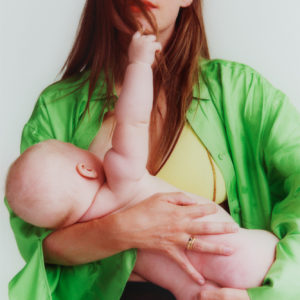Dymph de Gooijer
Interview 27.03.20
Words Britta Burger Photography Ramona Deckers Styling Giedre Malinauskaite

Tops and trousers by Acne Studios
Boots Dymph’s own
There’s an endless repertoire of clichés to describe a pretty woman who’s just stepped into a hotel lobby, private members club, or, in our case, a little breakfast place in the centre of Amsterdam to be interviewed. But why write about the luminosity of their skin or whether their radiance is impossible to ignore when beauty clearly isn’t their thing? “I don’t feel that art should be beautiful,” Dutch painter Dymph de Gooijer announces, and in the course of our conversation I come to realise that this is her artistic mantra. “It’s not important to me right now. People create so many beautiful things but it might not really be what they want, what comes flowing through them.”
What came flowing through Dymph when she started getting into painting wasn’t necessarily aesthetically pleasing. In fact, the realisation that art didn’t have to conform to any beauty standards was an epiphany for her. Visiting an Edvard Munch exhibition in Oslo at 14, she felt elated when she understood that art could be dark, that it did not have to be happy. Her teenage self immediately felt a creative kinship with the godfather of angsty expressionism: “I saw that his work didn’t make you feel happy but it made you feel so much.” Dymph had just given up dancing due to an injury and was looking for a new form of expressing herself. Her first attempts were rather dark, aggressive paintings with thick brush strokes and big faces, which only later developed into her current, more fluid style. Art, according to her, became the friendship she needed with herself and an escape from a school environment she didn’t feel comfortable in. A sympathetic teacher noticed that she couldn’t focus in class and turned a storage cupboard into her personal painting area. “A bit like Harry Potter,” she laughs. “I spent my last year of high school there, in that storage room.”


Dress by Uniqlo, belt Dymph’s own
She still isn’t very social, describes herself as a lone wolf, even hated Instagram at first, but eventually started seeing the social media platform as a useful tool to put herself out there. Not without reservations: “I’m having a hard time figuring out my Instagram,” she admits. In an age of personal branding it’s a challenge to just express yourself, which is what Dymph’s art is about. Her Instagram, however, shows a mix of images by and images of her. She paints primarily to explore herself, see herself in different ways, is interested in where her work comes from, or “comes out of” as she calls it. From that angle it makes sense to Dymph that images of her, of the physical source of her art, coexist with her paintings. At the same time she doesn’t necessarily see herself anymore when she sees a photo of her. “I just see what someone creates with my figure, I don’t look at it from a personal perspective.”

Top by Cecilie Bahnsen, trousers Zennghi

In keeping with her attitude towards pleasing aesthetics she is not overly concerned about whether she looks beautiful in a picture, which is particularly interesting considering she has even been in fashion shoots. So how does she consolidate her expressionist quest for turning her soul inside out with collaborating with an industry notoriously obsessed with the surface? She tells me about a design project with a clothing brand, which at first didn’t seem like something she might enjoy or that would fit her image. “But it felt good, so I thought why not? I created something with the mixed feelings and conflicting ideas I had about it.” Her policy now is to disregard hierarchies: “The art world can be exclusive, but it shouldn’t be.”

Apart from that Dymph just goes to her studio as often as she can. Sometimes she’s not in the mood and stares at the wall for hours, even weeks. Sometimes she’s extremely productive: “I can work all day, making a lot of pieces, I work very fast, my media are very flowy, creating beautiful shapes without me touching anything.” She knows it sounds extreme, but she assures me there are days where she produces 50 or 60 pieces of work. “I’m talking about small pieces of course!” Her art, expressive, fluid shapes, often female forms in shades of sepia, is not created to complement the colour scheme of people’s living rooms. But she can see why being appreciated by the general public is so important for artists. “Of course it’s also about sales, I understand that, and wanting to make something other people think is beautiful is very human, we all want to be liked.” A few weeks ago someone asked her why some of her figures have no hair, but they were quite clearly missing the point. “They are just basic human forms, without all the extra layers,” she says, and the stripped back starting point of almost all her work. She reads about philosophy, challenges preconceived ideas of light and dark, ponders the question whether there’s anything wrong with darkness and then paints what comes out of her.

Dress by Marni
And it works. Dymph had her first exhibition at only 16 and has been busy with solo projects, group shows and live painting events ever since. She mentions that people sometimes think that what she did was easy because she was a very young girl when she started and looked like she knew what she wanted. But she didn’t experience it like that: “Everything else was actually going really badly, so I just went for painting. First it was more of an outburst, now it’s something I truly love. But it’s pure coincidence that it worked out.”



